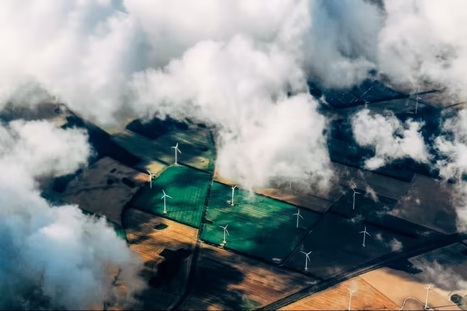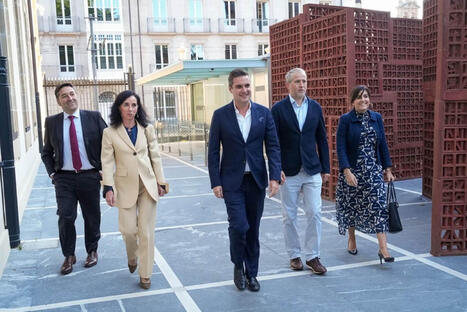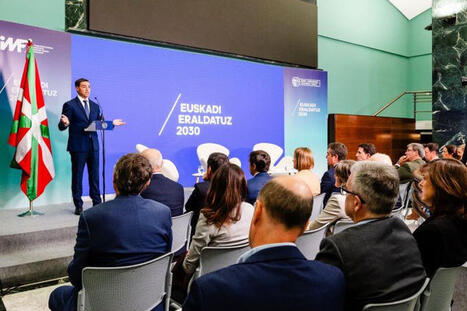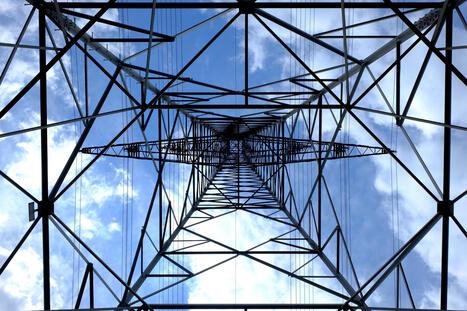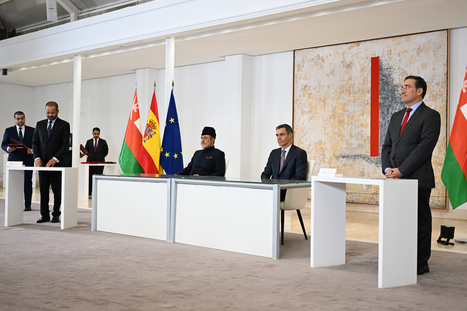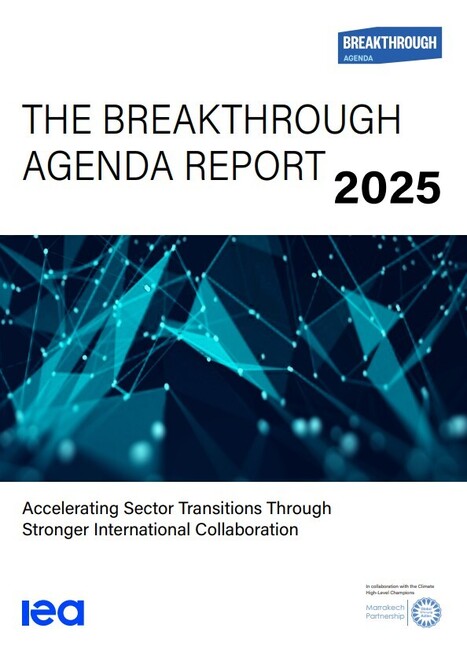 Your new post is loading...
Este viernes se ha publicado en el Boletín Oficial del Estado (BOE) la Orden TED/1252/2025, de 27 de octubre, que introduce modificaciones puntuales en la regulación de la producción de electricidad a partir de fuentes de energía renovables, cogeneración y residuos. En primer lugar, el artículo primero modifica dos aspectos de la Orden ITC/1522/2007, de 24 de mayo, por la que se establece la regulación de la garantía del origen de la electricidad procedente de fuentes de energía renovables y de cogeneración de alta eficiencia.
DNV’s 'Energy Transition Outlook North America 2025', forecasts a slower energy transition due to 2025 US policy shifts, delaying decarbonization by five to eight years. Fossil fuels would still meet 31% of final energy demand by 2060. Electricity demand is expected to rise 50% by 2040, driven by AI and electric vehicles, with solar and onshore wind reaching 55% of generation, though limited by permitting and grid constraints. Grid scale batteries could grow from 0,07 TWh in 2024 to 1,8 TWh in 2040, often paired with solar. Reduced IRA incentives, new tariffs, and continued support for oil and gas are steering capital toward lower risk assets, while state and provincial climate policies offer partial mitigation. Transmission expansion could save over USD 200 billion by 2050, and CCS and BECCS may capture more than 425 MtCO₂ annually by then, though technologies like DAC need stronger policy support to scale.
As the temporary lapse in appropriations (also called a government “shutdown” continues, the Department of Energy (DOE) has taken steps towards reducing waste, fraud, and abuse of taxpayer funds by cancelling grants given to organizations that do not promote activities in line with American priorities of reliable, affordable power. To preserve funds, the DOE has cancelled 321 grants and awards supporting 223 projects during the shutdown. This saves $7.56 billion. The DOE issued these grants under the Biden Administration, many of which were made in the last few months of the Administration. Most of these revoked grants were for spending on “green” energy projects or funded energy advocacy groups. Below are a few of the most wasteful projects and groups the Biden DOE funded which have since been canceled.
Countries around the world are contending with pressing energy security threats and growing longer-term risks across an unprecedented range of fuels and technologies, thrusting energy into the heart of geopolitical tensions and elevating it as a core issue of economic and national security. In this context, the latest edition of the IEA’s World Energy Outlook underscores the need for governments to pursue greater diversification of supplies and increased cooperation with one another to help navigate the uncertainties and turbulence ahead. The 2025 edition of the World Energy Outlook (WEO) covers a broad range of trajectories, highlighting different opportunities and vulnerabilities – but also commonalities. It does this through three main scenarios, none of which are forecasts. Each maps out a distinct energy future, enabling an analysis of the implications of different policy, investment and technology choices for energy security, affordability and emissions. Among the many trends common to all the scenarios in this year’s WEO is the world’s growing need for energy services over the coming decades – with demand rising for mobility; for heating, cooling, lighting and other household and industrial uses; and increasingly for data and AI-related services. In particular, a group of emerging economies – led by India and Southeast Asia and joined by countries in the Middle East, Africa and Latin America – comes to increasingly shape energy market dynamics in the years ahead. Collectively, they take up the baton from China, which accounted for half of global oil and gas demand growth and 60% of electricity demand growth since 2010, although no country or group of countries comes close to replicating China’s energy-intensive rise.
As momentum builds toward COP30, Rystad Energy has analyzed over 400 historical and updated NDCs to assess how well the global energy system aligns with the Paris Agreement goals. Most submissions focus on short-term decarbonization in power, energy and transportation, setting clear targets for renewables and electric vehicle (EV) adoption, with alternative fuels and carbon capture, utilization and storage (CCUS) for hard-to-abate sectors. This year, signatory countries are submitting their commitments under NDC 3.0. While many targets seem more ambitious, much of this reflects a shift in timelines from 2030 to 2035, rather than any stronger policy action. According to Rystad Energy's assessment, the latest NDCs project a trajectory consistent with a 1.7 °C pathway by 2035. Full implementation of these pledges could reduce emissions by about 25% (10 Gt) from current levels by 2035.
GlobalData reports that U.S. reciprocal tariffs originally introduced under the Trump administration are severely disrupting clean energy supply chains across the continent, undermining efforts to scale up renewable energy deployment. The firm’s latest analysis, published in the “North and South America Renewable Energy Policy Handbook 2025” shows that punitive duties on solar modules, wind turbines, transformers, and battery-related components have driven up costs and caused significant project delays, as domestic manufacturing capacity falls short of demand. These measures have strained trade with Canada and Mexico, added duties to cross-border transactions, and created logistical bottlenecks, while also slowing grid modernization and deterring investment in South America. According to Sudeshna Sarmah, Power Analyst at GlobalData, the resulting uncertainty and supply constraints are complicating long-term planning and delaying the continent’s shift toward a sustainable energy future.
Se ha publicado en el Boletín Oficial del Estado (BOE) el Real Decreto 997/2025, por el que se aprueban medidas urgentes para el refuerzo del sistema eléctrico. El objetivo es mejorar la supervisión, el control y la transparencia del sistema, al tiempo que se fomenta el almacenamiento energético, la repotenciación de instalaciones y la electrificación de la economía. Entre las principales medidas, se refuerza la supervisión del sector eléctrico: (i) La CNMC publicará, en un plazo de tres meses, un informe público sobre el control de tensión en el sistema eléctrico, que actualizará trimestralmente y remitirá a la Secretaría de Estado de Energía. Además, elaborará planes trienales de inspección sobre la capacidad de reposición del suministro. (ii) Además, Red Eléctrica, deberá proponer en un plazo de entre tres y seis meses, reformas normativas para mejorar la respuesta ante oscilaciones de potencia, variaciones de tensión y restricciones técnicas, así como nuevos procedimientos de coordinación y monitorización de incidentes. En cuanto al almacenamiento, el decreto facilita la integración de proyectos para alcanzar los 22,5 GW de potencia prevista en 2030 según el PNIEC, priorizando las hibridaciones con instalaciones existentes y simplificando la tramitación administrativa. Asimismo, se adoptan medidas para acelerar la electrificación industrial, limitando a cinco años la vigencia de los derechos de acceso y conexión y obligando a identificar el código CNAE de la actividad solicitante para evitar la especulación. Se reducen también los plazos de conexión eléctrica de las distribuidoras, que deberán responder en un máximo de 80 días en los casos más complejos, con el fin de favorecer la recarga eléctrica y nuevas actividades productivas. Finalmente, la norma establece una Hoja de Ruta nacional para la repotenciación que deberá presentarse en nueve meses, con medidas técnicas y financieras para modernizar instalaciones y aumentar la eficiencia energética. También se regula el régimen de las plataformas de I+D+i, simplificando la autorización de pruebas con prototipos de generación y almacenamiento, y se unifica la normativa sobre autorizaciones de puesta en servicio de instalaciones eléctricas.
BloombergNEF presented in its report 'CLIMATESCOPE 2025' a scenario of energy transformation in emerging markets, where investment in renewables grew from $49 billion in 2015 to $140 billion in 2024, nearly tripling its volume in a decade shaped by the Paris Agreement. The study notes that although solar power and regulatory frameworks for distributed generation have advanced significantly, the share of these economies in global clean energy spending remains limited to 18%, compared with 42% in developed countries and 40% in mainland China. BloombergNEF warns that political instability, currency volatility and high capital costs continue to hinder financing flows into developing nations, even in a context of reduced technology costs and rising demand for low‑carbon energy.
China installed a record 264 GW of wind and solar capacity in the first half of 2025, doubling the figures from the previous year as developers accelerated projects ahead of the shift to a new renewable pricing framework, according to Wood Mackenzie. The first provincial auction results under this system reveal strong downward pressure on prices, with solar bids 32% below average market levels and wind 9% lower, exposing the economic risks of full marketisation. The former auction-free mechanism, which guaranteed stable revenues at coal-fired base prices for 18 years, delivered internal rates of return of up to 11%, but the new structure shortens execution periods to 10 years and introduces exposure to price fluctuations and curtailment losses.
Los ministros de Industria de España, Alemania, Francia e Italia, junto con otros trece Estados miembros de la Unión Europea, han firmado la Declaración de Berlín, un acuerdo conjunto destinado a impulsar la competitividad, la innovación y la soberanía industria europea. La Declaración aborda cuestiones como la descarbonización, la digitalización industrial la inteligencia artificial, las materias primas críticas y el fortalecimiento de la industria de defensa europea. Los cinco ejes principales de actuación son: (1) Simplificación administrativa europea, (2) Aplicación de la inteligencia artificial en los procesos industriales, (3) Creación de mercados líderes europeos (acero, cemento, productos químicos) y fomento de la contratación pública verde, (4) Resiliencia industrial e innovación en defensa, (5) Fomento del liderazgo industrial y tecnológico: promoción de vehículos de cero emisiones, expansión de la infraestructura de hidrógeno y recarga, y apoyo a sectores como la biotecnología. La Declaración da continuidad al Informe Draghi sobre la competitividad europea y subraya la necesidad de una industria europea unida, capaz de responder a los desafíos globales mediante crecimiento, innovación y cooperación estratégica. Los países firmantes junto a España han sido Austria, Bélgica, Bulgaria, Croacia, República Checa, Finlandia, Francia, Alemania, Italia, Lituania, Luxemburgo, Países Bajos, Polonia, Rumanía, Eslovaquia, y Eslovenia.
La viceconsejera de Transición Energética del Gobierno Vasco, Irantzu Allende, ha sido la encargada de inaugurar el I Foro Vasco de Energía que organizó El Periódico de la Energía en Bilbao. Durante su discurso, Allende narró la ruta que el Gobierno Vasco quiere llevar a cabo para que Euskadi lidere la transición energética durante las próximas décadas. "Tenemos ante nosotros una década decisiva, una oportunidad histórica para avanzar juntos y asegurar un futuro sostenible, competitivo y descarbonizado para Euskadi", recalcó la viceconsejera. El objetivo no es otro que "nuestras empresas, grandes, medianas y pequeñas reduzcan emisiones, electrifiquen procesos y ganen competitividad". Para ello, ha destacado el Plan Industria Euskadi que lo ha dotado con 4.000 millones de inversión pública para traccionar una inversión privada de 12.000 millones de euros. Además, Allende ha querido destacar dos asuntos clave para poder lograr estos objetivos: por un lado, la eficiencia energética, con el objetivo de lograr una eficiencia del 12% para 2030, y, por otro lado, aumentar la independencia energética.
Surging power demand and mounting geopolitical tensions have made 2050 net zero goals unattainable, with the world now on track for 2.6°C of global warming, according to Wood Mackenzie's 'Energy Transition Outlook 2025-2026' report. The analysis shows that achieving a 2°C warming limit would require US$4.3 trillion in annual investment between 2025-2060 and reaching net zero emissions by around 2060. Energy sector investment must grow from 2.5% of global GDP today to 3.35% within the next decade. Key findings include: (1) Few countries in total, and no major G7 countries, are on track to meet 2030 emissions goals. (2) A significant investment increase could still limit the average temperature increase to within 2°C warming by reaching global net zero emissions by around 2060. (3) Energy sector capex must grow from 2.5% to 3.35% of global GDP to reach net zero. (4) Base case emissions trajectory has moved up slightly, with peak emissions in 2028 and the rate of decline slowing to 2% per annum since the last update, representing now a 2.6°C warming. (5) Variable renewables will surge from 20% of generation today to 60% by 2050, with solar alone doubling by 2030 and overtaking gas in 2033 and coal in 2034. Battery storage and nuclear provide flexibility to renewable-heavy grids. (6) Oil demand peak has shifted from 2030 to 2032, reflecting sluggish EV sales in the US and Europe, and continued momentum in petrochemicals. AI surge supports gas across all scenarios, pushing demand up by 180 bcm by 2050 than our previous outlook.
El Consejo de Gobierno ha aprobado el Proyecto de Presupuestos Generales de la Comunidad Autónoma de Euskadi para el ejercicio 2026. Como novedad, este Proyecto incluye 935 M€ contemplados para “Euskadi Eraldatuz 2030”, el Plan de Inversiones Transformacionales que representa la hoja de ruta de la Alianza Financiera Vasca, que se añaden al Proyecto de Presupuesto ordinario, la parte que es comparable con los presupuestos de ejercicios anteriores, y que asciende a 16.378 M€, un 4,1% más que el año pasado. Con este presupuesto, se impulsará la diversificación de PYMES hacia sectores HAZI (aquellos que tienen potencial de ser los sectores tractores del futuro) mediante Berrindartuz, un nuevo programa con una convocatoria de 40 M€. Asimismo, otro de los objetivos es promover la adopción de la IA y la Ciberseguridad, mediante una partida agregada de 22 M€ (frente a los 9,3 M€ de 2025).
|
This report analyses global electricity generation in the first three quarters of 2025 based on Ember’s electricity data. The analysis lays out global trends for electricity demand, the rise of renewable generation and the plateauing of fossil fuels. It also includes a forecast for the full year of 2025. The summary includes: (1) Record solar power growth pushes clean power above demand growth in the first three quarters of 2025. In Q1-Q3 2025, solar generation grew by 498 TWh (+31%), compared to the same period in 2024, the largest increase ever over a nine-month period. Solar output in the first three quarters of 2025 has already surpassed total output in all of 2024. Combined with moderate growth in wind generation of 137 TWh (+7.6%), total solar and wind growth (+635 TWh) exceeded the increase in demand of 603 TWh (+2.7%). Nuclear’s increase of 33 TWh was more than offset by a fall in hydro generation (-54 TWh). Consequently, fossil generation remained similar to 2024 levels, showing a minor fall (-17 TWh). (2) No fossil growth expected in 2025. This step up in clean power growth, combined with more moderate demand growth leads to Ember forecasting that fossil power will not rise in 2025. This would mark the first year without a fossil generation increase since the Covid-19 pandemic, when lockdowns caused electricity demand to fall. In the first three quarters of 2025, declines in fossil generation in China (-52 TWh, -1.1%) and India (-34 TWh, -3.3%) tipped the balance of the global trend in fossil generation, and even balanced out fossil increases in the EU and US.
En los primeros nueve meses del año, la inversión en tecnologías limpias en la Península Ibérica ha alcanzado la cifra de 747,1 millones de euros, lo que supone un significativo aumento respecto al mismo periodo del año anterior, según el último informe trimestral de Cleantech for Iberia. Este documento señala un notable crecimiento del interés inversor en estas tecnologías, consolidando a Iberia como un núcleo esencial para la innovación en tecnologías limpias y la industrialización verde en Europa. La mayoría de las operaciones se han centrado en sectores de ‘deeptech’ y áreas relacionadas con la infraestructura como la automatización, propulsión limpia, energía solar y materiales avanzados, lo que refleja un enfoque en soluciones escalables para la transición climática.
El Consejo de Gobierno ha aprobado el decreto por el que se autoriza al Instituto Vasco de Finanzas (IVF) la creación de la sociedad anónima pública «Indartuz kapitala, S.A.», fondo estratégico contemplado en el Plan de Inversiones Transformacionales “Euskadi Eraldatuz 2030”. Indartuz canalizará, junto a Finkatuz, la mayor parte de los recursos de los 1.000 millones de euros comprometidos por el Gobierno Vasco en el marco de la Alianza Financiera Vasca. El fondo Indartuz representa una nueva forma de actuar en la política financiera del Gobierno Vasco, un fondo de fondos para la inversión indirecta a través de vehículos de gestión privada, sin limitar la posibilidad de que realice inversiones directas en proyectos o empresas. El objeto de este fondo estratégico se enmarca en los propios de Euskadi Eraldatuz 2030, movilizar recursos, propios y externos, hacia inversiones transformadoras dirigidas a impulsar el arraigo, el crecimiento y competitividad del tejido empresarial vasco. En concreto, en el Plan de inversiones se identifican los programas a desarrollar por el fondo, relativos a deuda flexible, escalabilidad empresarial, infraestructuras de futuro, y transición social. Para el año 2025 contará con 65 M€ de recursos propios del Gobierno Vasco. Una de las novedades del Proyecto de Presupuesto 2026 para el próximo año es la inclusión de 935 M€ de endeudamiento adicional para “Euskadi Eraldatuz 2030”, que representa la hoja de ruta del compromiso del Gobierno Vasco en la Alianza Financiera Vasca. A esa cantidad se añaden estos 65 M€ iniciales para Indartuz con recursos propios y que permiten alcanzar la cifra redonda de los 1.000 M€ anunciados por el Lehendakari el pasado 3 de marzo.
This regional energy transition outlook for South America, developed by IRENA in collaboration with key regional partners, sets out a roadmap for a fair, inclusive and resilient energy transition, with the vision of achieving net-zero emissions in line with the global goal of limiting temperature rise to well below 2°C. South America has historically been a global leader in clean energy within the wider Latin American region, underpinned by a significant share of hydropower, wind and solar in power generation, and the extensive use of sustainable biofuels in end-use sectors. This strong foundation positions the region well for decarbonisation. Regional energy transition outlook: South America provides a comprehensive, quantitative analysis that identifies key technological pathways, investment and expenditure priorities, and recommended policy actions necessary to accelerate this transformation by 2050. At present, the region does not attract sufficient investment for the energy transition, receiving USD 58 billion in 2024, which represents only 2.5% of the global total of USD 2.4 trillion. To achieve its energy transition goals, South America needs to ramp up investment in projects and expenditure in goods for end-use applications to an average of USD 500 billion per year through 2050. Accelerating the energy transition would bring net economic and societal benefits that substantially outweigh the upfront costs. IRENA’s decarbonisation pathway shows that the region could increase its GDP growth by an additional 1.1% per year over the period 2023 to 2050 compared to current plans, while creating more than 12 million jobs in the energy sector.
El Departamento de Industria, Transición Energética y Sostenibilidad del Gobierno Vasco ha presentado un presupuesto de 750,5 millones de euros para 2026, un 18,9% más que en 2025, con 100 millones de euros aportados por el Instituto Vasco de Finanzas para aplicar el Plan de Industria Euskadi 2030. El gasto se concentra en fortalecer a las PYMEs, con un alza del 32,5% en sus ayudas, y en I+D+i, con un incremento del 13,4%. En transición energética, se destinan 80 millones de euros al autoconsumo, se avanza en el Hub de Combustibles Renovables y el proyecto Grid4Industry.
All emerging markets in the Group of 20 have bolstered low-carbon policy in the last year, according to BloombergNEF’s latest Policy Scoreboard, which tracks green government support across the G-20. This progress counterbalances backsliding by some high-income economies – in particular the US and, to a lesser extent, the European Union. Together, the G-20 accounts for roughly 75% of global emissions, meaning its action, or inaction, will largely determine the pace of the energy transition.
At the UN’s COP28 climate change conference in December 2023, world leaders reached a historic agreement to triple global renewables capacity by 2030. The International Energy Agency (IEA) and International Renewable Energy Agency (IRENA) both show that a global tripling of renewables to at least 11 TW by 2030 is the optimal pathway to keep 1.5C within reach. Despite the landmark COP28 agreement to reach 11 TW of renewables by 2030 and rising renewable capacity additions every year since, current national targets for 2030 only aim for just over a doubling of renewables by 2030. Tripling renewables is within reach, although stronger efforts are still required. Renewables are growing fast, proving they can deliver at scale. But achieving 1.5°C and ensuring secure power systems requires more than tripling alone. What’s needed is not just speed, but balance: between solar and wind, between generation and storage + grids, and ambition and delivery. This report analyses global renewable capacity additions since COP28 and assesses how on track the world is for a global tripling of renewables. This report also presents Ember’s analysis of national 2030 renewable capacity targets, covering 98 countries and the EU as a bloc.
Fundación Naturgy, junto a IESE Business School, celebró una edición especial de Energy Prospectives en la que se analizó la situación del mercado energético europeo y el balance del Informe Draghi tras su primer año de publicación. El continente se encuentra en una posición más frágil que entonces, con solo un 11,2% de las 383 recomendaciones plenamente ejecutadas, lo que refleja la necesidad de una reforma inmediata para lograr precios competitivos, agilizar permisos y coordinar la gestión de infraestructuras. El debate destacó que la descarbonización debe ser la palanca para alcanzar un continente independiente, competitivo y de alto crecimiento en un horizonte hasta 2035.
APPA Renovables presentó en Madrid el "Estudio del Impacto Macroeconómico de las Energías Renovables en España 2024", elaborado por Deloitte, que refleja un sector en crecimiento de potencia instalada pero en retroceso económico y laboral. La generación renovable alcanzó un récord con el 56,8% de la demanda eléctrica, sin embargo la aportación al PIB cayó a 0,95% y el empleo se redujo a 126.574 personas, encadenando dos años de contracción. El informe advierte que los vertidos de energía renovable superaron el 8% en 2024 y ya alcanzan el 17% en lo que va de 2025, mientras el consumo de combustibles fósiles aumentó un 5% y la electricidad apenas representa el 23,6% del consumo total de energía, situándose en niveles de 2007.
Se han firmado en Madrid dos Memorandos de Entendimiento (MoU) para impulsar la cooperación en materia de gestión, desarrollo y protección de los recursos hídricos y para cooperar en el campo de la transición energética limpia. Con relación al MoU relacionado con la cooperación en el campo de la transición energética limpia, España y Omán colaborarán en ámbitos como asegurar la diversificación de las fuentes de energía y asegurar el suministro a precios asequibles. Los dos países identificarán y desarrollarán proyectos de renovables, eficiencia energética, hidrógeno renovable, materias primas críticas –incluyendo el desarrollo de capacidades industriales y la apertura de mercados–, redes inteligentes y almacenamiento. Parte relevante de esta cooperación será la transferencia del conocimiento que ayude a materializar proyectos de cero emisiones, mediante la formación, la capacitación y la investigación científica, siempre con la debida protección de la propiedad intelectual. El MoU tendrá una validez de cinco años que se prorrogará automáticamente por otros cinco años, y ambos signatarios podrán ampliar su ámbito de actuación a otros campos de la transición energética limpia mediante los canales diplomáticos.
Emerging economies are expanding deployment of clean energy while seeking to strengthen domestic manufacturing of key technologies. As they pursue those goals, some nations are plotting higher import tariffs to protect local firms – a move that sits uneasily with rising clean-tech imports and which could increase the cost of the energy transition. The Clean Energy Trade and Emerging Markets report – produced by BloombergNEF and commissioned by Bloomberg Philanthropies – assesses how trade and industrial policy are reshaping flows of clean technology. It examines electric vehicles (EVs), batteries, solar products and wind turbines to help policymakers weigh the trade-offs between industrial strategy and decarbonization. Industrial policy is enjoying a global revival. China sits at the center of clean-tech manufacturing – hosting at least 80% of capacity across major parts of the solar and battery supply chains – and it is against this backdrop that governments are seeking to strengthen their own industrial capacity. Exports from China to Asia, Africa and Latin America are booming, with low-cost solar panels, batteries and EVs helping accelerate the energy transition in power generation, storage and transport. Clean-tech imports are reshaping markets – from record solar installations in Pakistan to an influx of EVs in Brazil.
Acting together, countries, companies and international initiatives can harmonise standards, aggregate demand and mobilise finance in ways that are nearly impossible to achieve in isolation, according to the latest Breakthrough Agenda report. The new report - an annual collaboration between the International Energy Agency (IEA) and the Climate High-Level Champions - identifies practical opportunities for countries to work together in ways that advance both economic development and energy security while reducing emissions. At a testing time for international cooperation, they also underscore its importance to avoid market fragmentation and falling short of the Breakthrough Agenda goals.
|



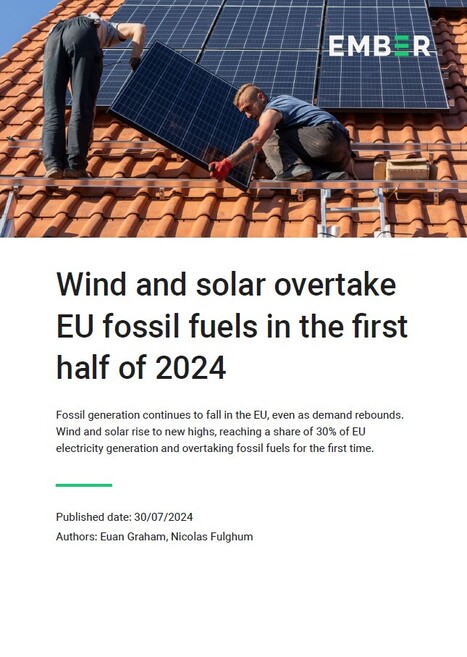







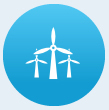







 Your new post is loading...
Your new post is loading...
